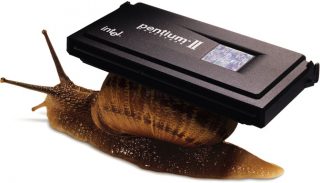2000: Apple’s partnership with Motorola has deteriorated into a comedy of errors over the last year or so. Production problems, pricing fiascoes, and hitting the MHz brick wall have all contributed to a black eye for Apple.

 The perceived “slowpoke” status of the Macs does nothing for marketing and doesn’t help sales. Those grand “snail” ads from a couple of years ago don’t help matters much. What goes around….
The perceived “slowpoke” status of the Macs does nothing for marketing and doesn’t help sales. Those grand “snail” ads from a couple of years ago don’t help matters much. What goes around….
MHz Does Matter
Hollering “MHz don’t matter” is just preaching to the tech literate crowd, not the average Jane in the store.
IBM is out there with faster PPC chips, but the taboo of sleeping with the enemy rarely rears its head. What if Apple got cozy with Intel? This speculation is not new, but Mac OS X opens up some intriguing possibilities. Theoretically, making OS X run on Intel hardware is just a recompile away.*
But Intel???
Are there advantages to this? Intel may be just as bad a chip partner as Motorola. Rather than focusing on delivering the best products, Intel has been chasing the Will ‘o the Wisp speed crown of AMD. Intel’s production problem with its own 1.13 GHz chips is hardly a sign of a solid supplier.
So what can Apple really do about Motorola’s poor performance? Motorola is a massive company with plenty of other revenue streams. Is Apple’s weight as a buyer big enough for them to start making threats against Motorola?
While Apple’s chip business may not make up the bulk of Motorola’s sales, losing Apple’s business would definitely have a negative impact on the bottom line. Motorola is likely not in a position to simply dismiss sales to Apple as inconsequential.

Summer 2000 iMac colors
Apple has managed to keep things spiced up with ever faster iMacs and a dual processor G4. Unfortunately, the line is now pretty much maxed out. There is no more speed to give.
Unless Motorola comes out with some faster chips quickly, Apple will likely be in trouble with investors. New products only go so far if the chassis remains the same, and there are only so many ways that you can improve a computer before that clock speed starts looking pokey.
Theoretically, Apple can still introduce G4 iMacs,** but what comes after that?
Of course, every cloud has a silver lining. The longer chip speeds stay the same, the better off current owners will be. No need to worry about processor envy when everyone is maxed out.
It’s time for Apple to start brandishing the big stick. OS X can work on Intel, AMD, and Transmeta. Why wait for Motorola, which doesn’t seem to be too interested in staying ahead of the pack?
Time is growing short, and the next Mac lineup refresh had better include something more than low-end iMacs with faster processors.
* We had no idea back then that Apple was doing exactly that, developing OS X on Intel processors in parallel with the PowerPC version. And in June 2005, Apple shocked the Apple world by announcing it would leave PPC behind in 2006. Apple further surprised us by actually delivering Intel-based Macs in January 2006.
** The iMac G4 was only a few months away when this was first published, debuting in January 2001.

